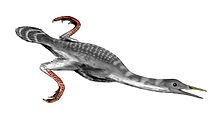- Ornithurae
-
Ornithurans
Temporal range: Early Cretaceous–Recent, 136–0 Ma
Artist's restoration of Hesperornis regalis Scientific classification 
Kingdom: Animalia Phylum: Chordata Class: Aves Node: Ornithothoraces clade: Ornithurae
Haeckel, 1866Subgroups Ornithurae (meaning "bird tails" in Greek) is the name of a natural group which includes all modern birds as well as their extinct relatives with plough-shaped pygostyles, a bone at the end of the tail which allows the tail feathers to fan and retract.
Taxonomy
Ernst Haeckel coined the name in 1866 and included in the group all "true birds" with the "characteristic tail morphology of all extant birds" (translation by Jacques Gauthier). This distinguishes the group from Archaeopteryx, which Haeckel placed in another new group called Sauriurae. Said simply, modern birds have short tails, while Archaeopteryx has a long tail like that of theropod dinosaurs.[1]
Gauthier converted Ornithurae into a clade, giving it a branch-based definition: "extant birds and all other taxa, such as Ichthyornis and Hesperornithes, that are closer to extant birds than is Archaeopteryx". Later he and de Queiroz redefined it as an apomorphy-based clade more in keeping with Haeckel's original usage, including the first panavian with a "bird tail" homologous with that of Vultur gryphus, and all of its descendants.[2] They defined "bird tail" as a tail that is shorter than the femur, with a pygostyle that is a ploughshare-shaped, compressed element, with the bones fused in the adult, composed of less than six caudal vertebrae, and shorter than the free part of the tail, which itself is composed of less than eight caudal vertebrae. They included Aves (which they defined as the "crown group" of modern birds), Ichthyornis, Hesperornithes, and Apsaravis in Ornithurae.
Neornithes was originally proposed as a replacement for Ornithurae by Gadow in 1892 and 1893. Gauthier and de Queiroz, therefore, consider Neornithes a junior synonym of Ornithurae,[2] though many other scientists use Neornithes to refer to the much more restrictive crown group consisting only of modern birds (a group for which Gauthier uses the name Aves). Alternately, some researchers have used Ornithurae to refer to a more restrictive node-based clade, anchored on Hesperornis and modern birds.[3]
Clarke at al. (2006) found that Yixianornis, Songlingornis, and Yanornis form an unnamed clade which is the most basal group in the Ornithurae (following the apomorphy-based definition). They found that this group has a mosaic of advanced and primitive features. These three taxa retain primitive features like gastralia and a pubic symphysis. They also show the first fully modern pygostyles, and the type specimen of Yixianornis (IVPP 13631) preserves eight elongated rectrices in a modern arrangement. No earlierpygostylians are known which preserve a fan of rectrices of this sort; instead they show only paired plumes or a tuft of short feathers.[4]
References
- ^ Haeckel, Ernst (1866). Generelle Morphologie der Organismen. Berlin: Georg Reimer.
- ^ a b Gauthier, Jacques, de Queiroz, Kevin (2001). "Feathered dinosaurs, flying dinosaurs, crown dinosaurs, and the name 'Aves'". in New Perspective on the Origin and Evolution of Birds: Proceedings of the International Symposium in Honor of John H. Ostrom. Yale Peabody Museum. Yale University. New Haven, Conn. USA
- ^ Chiappe, Luis M. (2007). Glorified Dinosaurs: The Origin and Early Evolution of Birds. Sydney: University of New South Wales Press. ISBN 978-0-86840-413-4.
- ^ Clarke, Julia A., Zhou, Zhonghe, Zhang, Fucheng (2006) "Insight into the evolution of avian flight from a new clade of Early Cretaceous ornithurines from China and the morphology of Yixianornis grabaui". Journal of Anatomy 208:287-308.
Categories:- Birds by classification
Wikimedia Foundation. 2010.
